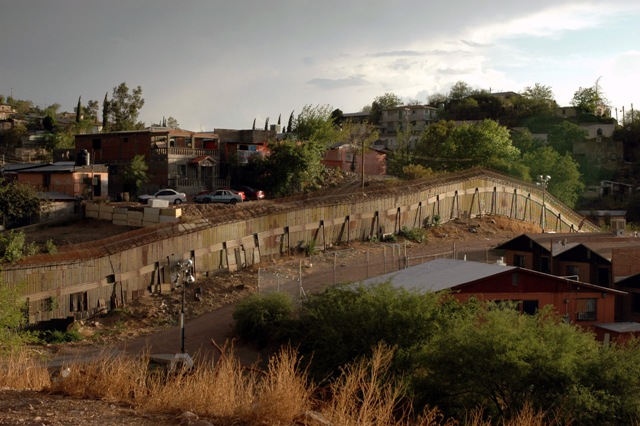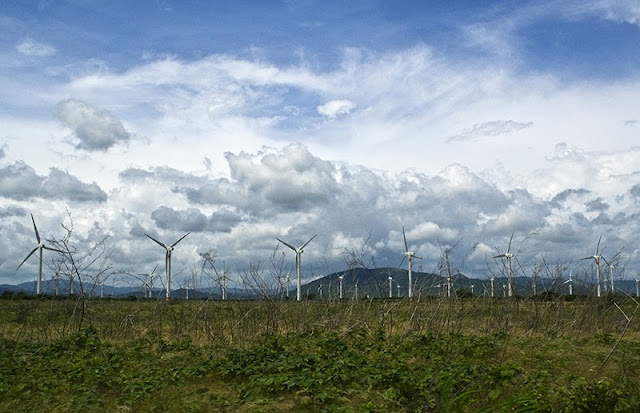-
A Blueprint for Action on the U.S.-Mexico Border
›September 17, 2010 // By Robert DonnellyAt the U.S.-Mexico border, environmental degradation is a chief concern affecting both countries’ shared watersheds, “airsheds,” and greater ecosystems. At the same time, continuing population stresses in the U.S. Southwest are further aggravating the area’s perennially acute water needs, while climate change is threatening to make the region even hotter and drier.
Compounding these ecological challenges and their consequent health risks is the fact that the poverty on both sides of the border appears largely intractable, at least in the short-to-medium term. Yet the region and its shared challenges also present unique opportunities for enhanced U.S.-Mexico collaboration, particularly in the areas of joint environmental management, cross-border emergency response, and renewable energy development.
Earlier this summer, the Woodrow Wilson Center’s Mexico Institute looked to address these challenges and opportunities by co-sponsoring an event with the Good Neighbor Environmental Board (GNEB), an independent federal advisory committee (coordinated by the Environmental Protection Agency) that advises the U.S. government on border environmental practices. The event revolved around the release of the board’s new report, A Blueprint for Action on the U.S.-Mexico Border.
Initiatives Show Promise
Chief among the report’s 63 policy recommendations is the need for better coordination among and between federal, state, and local agencies at the border. GNEB Chair Paul Ganster cited the report’s support of a transboundary environmental impact assessment (TEIA) process “to address transnational (environmental) impacts, and encourage transborder cooperation on environmental infrastructure projects.” The report suggests that the trilateral Commission on Environmental Cooperation (CEC)—comprising Mexico, Canada, and the United States—“explore such an agreement.”
Ganster added that U.S. border communities require dedicated focus from the government in ways that non-border communities might not because of their unique and poverty-aggravated environmental challenges.
Michelle DePass, an assistant administrator at the Environmental Protection Agency’s Office of International and Tribal Affairs, said that the board’s findings would be used in the search for solutions to border-region environmental challenges. She acknowledged recent advances in tackling such challenges, such as EPA-coordinated efforts to reduce the serious environmental threat posed by heaps of tires scattered throughout the region.
DePass also described the EPA’s U.S.-Mexico Environmental Program, known as Border 2012, highlighting its successful involvement in efforts to clean up the Metales y Derivados industrial waste site in Baja California.
Nancy Sutley, chair of the White House Council on Environmental Quality, said that the border region is poised to become part of a “clean energy revolution” because of its supply of renewable resources. She lauded the report for encouraging clean-energy collaboration with Mexico, and said the report’s recommendations have a special significance because they are issued by individuals who actually live and work in the border region.
Bilateral collaboration is necessary to mitigate the adverse effects of climate change and to resolve shared environmental problems at the border, said Enrique Escorza, an official with the Political Affairs Section of the Mexican Embassy in Washington, D.C. Escorza said the need for collaboration has finally eclipsed prior impediments, such as concerns about violations of national sovereignty.
“The border throws us together,” Escorza said, adding that Mexico has a new understanding about shared resources. “It’s not about ‘our’ water,” he declared. “It’s about shared watersheds and our working as partners.”
A Federal, State, and Local Stakeholder Perspective
Duncan Wood, acting chair of the Department of International Relations at the Instituto Tecnólogico Autónomo de México (ITAM), noted that the border region presents enormous opportunities in the area of renewable energy investment. The border is a unique region, he added, since ecosystems overlap rather than respect national boundaries. He drew linkages between the report’s policy options for improving the border and two pillars of U.S.-Mexico security cooperation policy: the development of a 21st century border where security and trade concerns complement one another, and the construction of resilient border communities.
Russell Frisbie, the Washington liaison for the International Boundary and Water Commission (IBWC), and John Wood, a county commissioner in Cameron County, Texas, both discussed the need for a bilateral federal-to-federal memorandum of understanding on cross-border emergency-management response. The development of such a protocol could help first responders in both countries more easily cross the border to provide relief in the event of natural disasters, such as floods or wildfires.
Allyson Siwik, executive director with New Mexico’s Gila Resources Information Project, seconded the report’s recommendation for a successful Transboundary Aquifer Assessment Program, which would, according to the GNEB report, “scientifically characterize aquifers that underlie the international boundary and encourage other efforts to improve data gathering and accessibility for border water resources, such as harmonization of standards.” Ann Marie A. Wolf, president of the Sonora Environmental Research Institute (Arizona), called for upgrades to water and wastewater systems in border sister cities, some of which suffer regular overflows from flooding.
Siwik also stressed an ongoing need to assess the environmental impact of security fencing along the border, which Wood said prevented the natural movement of animal species, while not effectively deterring unauthorized migration.
Robert Donnelly is a program associate with the Mexico Institute at the Woodrow Wilson Center.
Photo credit: “U.S.-Mexico border fence at Nogales, Arizona,” courtesy of flickr user jim.greenhill. -
U.S.-Mexico Cooperation on Renewable Energy: Building a Green Agenda
›Could joint green-energy development help improve relations between the United States and Mexico? Speakers at this spring’s launch of “Environment, Development and Growth: U.S.-Mexico Cooperation in Renewable Energies,” a report released by the Woodrow Wilson Center’s Mexico Institute, agreed that cooperating on renewable energy is a positive step. However, the panelists asserted that cooperation could be maximized by better harnessing Mexico’s renewable resources and by leveraging the economic complementarities that exist among the border states.
Mexico’s Green Energy Potential
Mexico has large untapped areas of geothermal, wind, and solar potential, according to Duncan Wood, author of the Wilson Center report and chair of the Department of International Relations at the Instituto Tecnologico Autonomo de Mexico (ITAM). Already, the country is the world’s third-largest producer of geothermal energy, and has large geothermal deposits in Baja California near major U.S. markets, such as San Diego and Los Angeles.
Mexico also offers great promise in wind power, with an estimated potential output of 1,800 to 2,400 megawatts for Baja California and 5,000 megawatts for southern Oaxaca state. Though Oaxaca is far from the U.S. border, it will soon be able to export electricity to U.S. markets, once Mexico’s mainland electrical grid is connected to the United States.
Wood also pointed out that Mexico is rich in solar energy, which could be marketed to the United States—particularly from the Baja California peninsula, which is the only part of the Mexican grid currently connected the United States. In biomass, he added, little investment has been made so far.
Opening New Avenues for Collaboration
With Mexico’s oil fields experiencing long-term and, in some cases, precipitous declines, the country is plotting a “future as a green nation,” shifting its policy focus toward alternative energy development, said Wood. In addition, Mexico’s renewable sector does have not the blanket prohibitions on private ventures that exist in the hydrocarbons sector, and regulatory adjustments over the past few administrations have enabled a more robust private stake in electricity generation and transmission.
A U.S.-Mexico taskforce on renewables was recently formed—an announcement timed to coincide with President Felipe Calderon’s April 2010 state visit to Washington—and there has been high-level engagement on the issue by both administrations. Collaboration between Mexico and U.S. government agencies through the Mexico Renewable Energy Program has enabled richer development of Mexico’s renewable resources while promoting the electrification and economic development of parts of rural Mexico. Joe Dukert, an independent energy analyst affiliated with the Center for Strategic & International Studies, pointed out that U.S.-Mexico collaboration on renewables is a little-acknowledged area of bilateral cooperation, and stressed the economic complementarities that exist between the two countries on the issue. He noted, for example, that Mexico was well-positioned to furnish power to help California meet its Renewables Portfolio Standard (RPS) by 2020.
Joe Dukert, an independent energy analyst affiliated with the Center for Strategic & International Studies, pointed out that U.S.-Mexico collaboration on renewables is a little-acknowledged area of bilateral cooperation, and stressed the economic complementarities that exist between the two countries on the issue. He noted, for example, that Mexico was well-positioned to furnish power to help California meet its Renewables Portfolio Standard (RPS) by 2020.
“Mexico can help them reach these [renewable energy] targets,” Dukert said. Yet at the same time, he said that Mexico needs to do more to enhance its profile as a renewable-energy supplier, and specifically suggested that energy attaches be assigned to the embassy and consulates.
Johanna Mendelson Forman, a senior associate with the Americas Program at the Center for Strategic & International Studies, emphasized the linkages connecting climate change, energy, and economic development. Forman warned that Mexico’s inadequate energy stocks are a problem for the United States, adding that “energy poverty is a real issue in Mexico.” Energy development and climate change—which are perceived as less polemical than other issues—are good entry points for a broader U.S.-Mexico dialogue, she remarked.
Robert Donnelly is a program associate with the Mexico Institute at the Woodrow Wilson Center.
Photo Credit: “Wind Mill Farm (Mexico),” courtesy of flickr user Cedric’s pics. Speaker photos by David Hawxhurst/Wilson Center.
Showing posts by Robert Donnelly.








